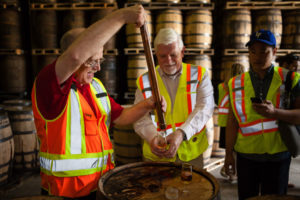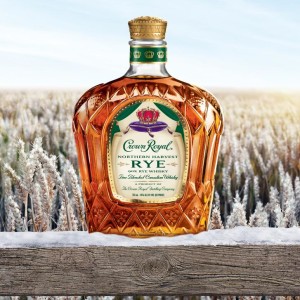By Father John Rayls
Crown Royal is the top-selling Canadian whisky in the U.S. and second best in the world, while ranking as the eight biggest world whiskey brand overall. Yet you would never guess this from looking at the map.
The Crown Royal Distillery is located about 1 1/2 hours north of beautiful Winnipeg in Gimli, Manitoba near the shores of Lake Winnipeg. The lake is one of the ten largest freshwater lakes in the world, making it a bucolic, rural setting in central Canada. Yet alongside the 6,000 residents of Gimli, Diageo (the owner of Crown Royal) is currently aging 1.56 million barrels of whisky in 50 warehouses on 360 sprawling acres.
Let that barrel number sink in a while. In Kentucky, they think its a big deal that several big distilleries, a few medium sized plants and a couple dozen craft distilleries together have amassed more resting barrels than the state’s 4.4 million people. Crown Royal alone has 1 1/2 million casks, outnumbering the 1.2 million people living in Manitoba. It’s truly staggering.
Crown Royal’s Lone Star Connection
Crown Royal was introduced in 1939 to honor King George VI and Queen Elizabeth (Elizabeth II’s mother), who were the first reigning British monarchs to visit Canada. Approximately 10 cases were made to stock their train for the tour.
The brand that started with that pre-war visit wasn’t released to the US market until the 1960s, and, strangely, my home state of Texas led the way. Supposedly, Canadian oil workers in Texas demanded their own whisky designed for their tastes. It’s interesting to note that Crown Royal is still the best selling whisky in Texas, on top of being the best selling Canadian whisky in America. The calling card Edwardian bottles and velvet-like presentation bags are easily identified, a testament to Crown Royal’s popularity.
Gimli’s Great Big Distilling Plant
Bottling is no longer done at Gimli, but most of the aged whisky is shipped for bottling and distribution. That isn’t surprising, since parent company Diageo is an international drinks mega-giant and tends to centralize things like that. What they do in Gimili is make whisky. A whole lot of whisky.
Crown Royal distills about 50 different whiskies, serving as ingredients in crafting a specific flavor profile for a specific expression. How each of those distinct whiskies comes into being is a matter of changes in the production process, from mash bill to maturation. This is similar to how Four Roses (once owned by the Canadian Seagrams) uses two mash bills and five yeasts to create ten recipes, only on a much wider scale.
Canadian Whiskey has this broad flexibility because its rules are flexible and few in number. These consist of two major absolutes: 1) it must be aged for a minimum of three years; 2) and that in a wood cask of not more than 700 liters capacity. Past that, there are rules commonly in force around the world or obvious: whisky must be fermented from grain; it must be bottled at at least 40% alcohol content; and it must be made in Canada. The law even specifies that caramel and coloring may be added, and this can be up to about 9% of the total content of the whisky.
The wood cask regulation doesn’t even necessarily command the use of oak, although oak is almost invariably used. However, the Canadian whisky style relies on both new oak, as in America, and old oak, as in Ireland and Scotland. This adds another point of divergence for those 50 different whiskies, with one type of new make becoming two types of whisky after years of maturation in two very different casks.
In terms of mash bills, Crown Royal practices the Canadian method of using several distinctive recipes and blending them together. A particular whisky at Crown Royal may or may not be a rye as Americans understand it, and the same can be said for the final product. However, Canadians often refer to all of their whisky as rye, which causes some confusion for North Americans south of the border, who are accustomed to less freedom and flexibility in their whisky-making.
The Crowning Product
Canada is filled with lots of very nice people, Manitoba in particular. This is so much so that comments and jokes about “Canadian Nice,” “Canada is the nice version of America,” and so on are commonplace.
Just like the people who live and work there, Canadian whisky reflects a culture of niceness. Don’t think of the loud guy at the head of the table, but rather the quiet, self-confident individual holding court more discretely. It’s smooth and consistent whisky. That is the Canadian style in so many ways, and especially so for Crown Royal
 The Whiskey Reviewer A World of Whiskey, Poured Every Weekday
The Whiskey Reviewer A World of Whiskey, Poured Every Weekday



